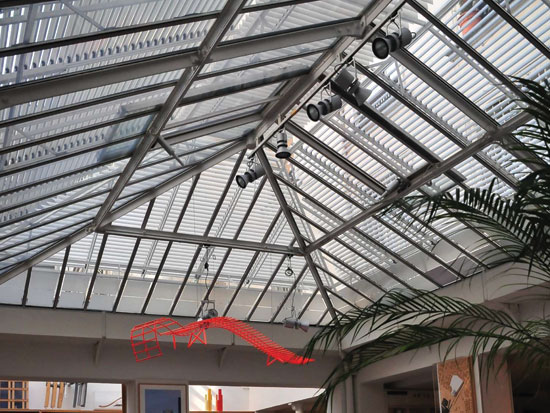Managing Heat and Light Through Exterior Shading Systems
Rack Arm System
The rack-arm system is a non-retractable louver system. It can effectively shade any type, shape or any orientation of glazing and provides very effective solar control. Further, the rack arm system can provide high levels of light exclusion (but not blackout), particularly if an interlocking slat is used.
Rack arms are installed to the glazing structure. Spacing is dependent on whether the installation is interior or exterior as well as on the slat size. Rack arms are connected by a drive shaft that in turn is connected to the operator. Slats are mounted onto the rack arms. It's important to note that the slats rotate between open and closed but the system, unlike a venetian blind, cannot be retracted.
The rack system has been developed for exterior use and, if designed and installed correctly, can withstand wind speeds in excess of 100mph. In exposed locations it is appropriate to use baffles to protect the slats around the edge of the system; it is also recommended that a wind control feature is used and that the slats are moved to the open position in strong winds to allow an equalization of pressure. This reduces slat movement and makes the system much more stable.
The rack arm system has a large number of small rotating parts which makes ice a potential issue, particularly with motorized systems. Projects therefore need to be carefully considered and, in some locations, an interior installation is probably the only realistic option. In many parts of the U.S., however, the system is certainly viable as an exterior system.
Another advantage of the rack system is that it possesses the flexibility to deal with various shapes of glazing. Not only can it be installed on vertical, sloped and horizontal glazing, it can also be designed to shade triangular and circular openings, etc. No other shading system is able to effectively deal with these types of requirements. Further, the system has been used in museums and galleries throughout the world where the need for precise light control is particularly important.
Shading a skylight. Rack arm systems are primarily used to shade skylights. Consider the accompanying graphs that were generated using software and show the incident solar radiation by façade orientation.

Image courtesy of Draper, Inc.
Contrary to general expectations, the radiation on the south elevation is least significant in the summer months. This is because of the high sun angles and the oblique angle of the sun to the glazing. The incident radiation on the roof glazing, however, is much greater than is the case with any of the vertical façades during the period from March to September. The amount of solar radiation as shown in graphical format clearly shows this and highlights why the shading of horizontal and inclined glazing should be considered during the design phase of a building.

Photo courtesy of Progressive Commercial Interiors
For skylight shading at a Paris office, an exterior rack arm system provides light and solar control while enabling the shading of triangular glazing elements.
For skylight shading at an office in Paris, an exterior rack arm system provides very effective light and solar control and also enables the triangular glazing elements to be shaded. The Paris climate means that using the system on the exterior is possible, and that weather-related risks are not a significant issue. By installing the system on the exterior, very good solar control is achieved, reducing heat gain inside the office during the summer months. The adjustability of the louver angle means that direct sun penetration is prevented, ensuring high levels of natural daylight, without the problems of glare, for people working in the office below the skylight.
Control Systems for Exterior Shading
Operable exterior shading systems will require a control system. As a minimum they will need to be protected against wind and systems such as venetian blinds and roller shades will, as already highlighted, need to be retracted if the wind speed is too high. Given that exterior systems are designed to control heat gain into the building, they will generally be automated and will respond to the sun conditions. This means that systems will automatically deploy and retract and the slats of venetian blind systems will move between different tilt angles to prevent direct sun penetration. Because this is the case, it's important that the building users understand the function of the systems and are given initial training or a briefing about how the systems work and how they help control the building environment and create good working conditions. User override of the systems also needs to be considered at an early stage. Control systems will generally allow varying degrees of user override and will also capture systems back into automatic after a period of time to ensure that solar control of the building is maintained.
Exterior Shades Manage Heat and Light
When it comes to efficiently managing heat and glare with maximum effective daylighting potential, exterior shading systems offer unique benefits. Through enhanced user comfort, decreased energy costs, and a significant addition to overall project sustainability, exterior systems are becoming recognized as a desirable option in the toolbox of U.S. architects, just as they have been a staple for decades in European design.
Draper, Inc. is a Spiceland, Indiana-based manufacturer of window coverings, audio visual equipment, and gymnasium equipment. Draper has more than 110 years of experience in the window coverings industry. www.draperinc.com |









